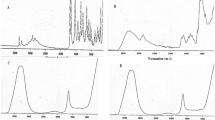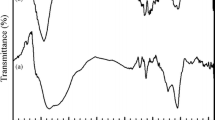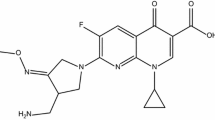Abstract
Controlled release drug delivery systems have traditionally been regarded as useful devices in the treatment of a variety of disorders. The objective of the present study is the optimization and thermal behavior of graphene oxide (GO) incorporated chitosan (CH) and sodium alginate (ALG)-based nanocomposite. Various reaction parameters such as temperature, time, amount of solvent, ratio of backbones, amount of GO and pH were optimized to obtain maximum percentage swelling. Thermal stability of nanocomposite was analyzed by thermal gravimetric analysis (TGA). Advanced characteristics of GO have been exploited, including a two-dimensional plan surface with several functional groups, improved biocompatibility, low cost, water solubility, and a huge specific surface area available for high drug loading, among others. Because of these characteristics, graphene oxide is an excellent material for loading and releasing a wide range of drugs. Paracetamol (PCM) is widely used as an antipyretic and analgesic. It is sparingly soluble in water. Inclusion complexes were prepared to improve the solubility of drug by host guest interactions. Phase solubility study implies the 1:1 complexation between PCM and β-CD. Inclusion complexes prepared by physical, kneading, co-precipitation and microwave method were characterized by 1H NMR, ROESY, FT-IR, XRD and SEM. The inclusion complexes were directly loaded into the nanocomposite and the release study of drug was investigated in gastric (pH 2) and intestinal fluids (pH 7.4) at 37 °C. Four kinetic models were applied to investigate the possible mechanism of drug release. From kinetic models, it was concluded that Peppas-Sahlin and Korsmeyer-Peppas equation followed drug release mechanism. Complexation with β-CD leads to slower the drug release rate from the ICs loaded nanocomposite.
Graphical abstract









Similar content being viewed by others
Abbreviations
- ALG :
-
Sodium Alginate
- β-CD :
-
β-Cyclodextrin
- CH :
-
Chitosan
- CP :
-
Co-precipitation Method
- GO :
-
Graphene oxide
- ICs :
-
Inclusion Complexes
- KM :
-
Kneading Method
- MW :
-
Microwave Method
- PM :
-
Physical Method
References
Taylor-Pashow KML, Della Rocca J, Huxford RC, Lin W (2010) Hybrid nanomaterials for biomedical applications. Chem Commun 46:5832–5849. https://doi.org/10.1039/c002073g
Allen TM, Cullis PR (2004) Drug delivery systems: entering the mainstream. Science 303:1818–1822. https://doi.org/10.1126/science.1095833
Wilczewska AZ, Niemirowicz K, Markiewicz KH, Car H (2012) Nanoparticles as drug delivery systems. Pharmacol Rep 64:1020–1037. https://doi.org/10.1016/S1734-1140(12)70901-5
Cho K, Wang X, Nie S et al (2008) Therapeutic nanoparticles for drug delivery in cancer. Clin Cancer Res 14:1310–1316. https://doi.org/10.1158/1078-0432.CCR-07-1441
Liu J, Cui L, Losic D (2013) Graphene and graphene oxide as new nanocarriers for drug delivery applications. Acta Biomater 9:9243–9257. https://doi.org/10.1016/j.actbio.2013.08.016
Geim AK (2009) Graphene: status and prospects 324:1530–1535
Kakran M, Li L (2012) Carbon nanomaterials for drug delivery. Key Eng Mater 508:76–80. https://doi.org/10.4028/www.scientific.net/KEM.508.76
Sun X, Liu Z, Welsher K et al (2008) Nano-graphene oxide for cellular imaging and drug delivery. Nano Res 1:203–212. https://doi.org/10.1007/s12274-008-8021-8
Liu Z, Robinson JT, Sun X, Dai H (2008) PEGylated nanographene oxide for delivery of water-insoluble cancer drugs. J Am Chem Soc 130:10876–10877. https://doi.org/10.1021/ja803688x
Wang Y, Li Z, Hu D et al (2010) wang2010 Aptamer.pdf. 9274–9276
Lu CH, Zhu CL, Li J et al (2010) Using graphene to protect DNA from cleavage during cellular delivery. Chem Commun 46:3116–3118. https://doi.org/10.1039/b926893f
Feng X, Lv F, Liu L et al (2010) Conjugated polymer nanoparticles for drug delivery and imaging. ACS Appl Mater Interfaces 2:2429–2435. https://doi.org/10.1021/am100435k
Manna U, Patil S (2010) Glucose-triggered drug delivery from borate mediated layer-by-layer self-assembly. ACS Appl Mater Interfaces 2:1521–1527. https://doi.org/10.1021/am100139j
Zhao J, Lu C, He X et al (2015) Polyethylenimine-grafted cellulose nanofibril aerogels as versatile vehicles for drug delivery. ACS Appl Mater Interfaces 7:2607–2615. https://doi.org/10.1021/am507601m
Hoffman AS (2012) Hydrogels for biomedical applications. Adv Drug Deliv Rev 64:18–23. https://doi.org/10.1016/j.addr.2012.09.010
Conceição J, Adeoye O, Cabral-Marques HM, Lobo JMS (2018) Cyclodextrins as excipients in tablet formulations. Drug Discov Today 23:1274–1284. https://doi.org/10.1016/j.drudis.2018.04.009
Davis ME, Brewster ME (2004) Cyclodextrin-based pharmaceutics: Past, present and future. Nat Rev Drug Discov 3:1023–1035. https://doi.org/10.1038/nrd1576
Crini G (2014) Review: a history of cyclodextrins. Chem Rev 114:10940–10975. https://doi.org/10.1021/cr500081p
Raju LJ, Werner MKR (2014) A vision for cyclodextrin nanoparticles in drug delivery systems and pharmaceutical applications. Nanomedicine 9:877–894
Brewster ME, Loftsson T (1996) Pharmaceutical applications of cyclodextrins. 1. Drug solubilization and stabilization. J Pharm Sci 85:1017–1025
Fenyvesi VM, Szente L (2016) Cyclodextrins in food technology and human nutrition: benefits and limitations. Crit Rev Food Sci Nutr 56:1981–2004. https://doi.org/10.1080/10408398.2013.809513
Stella VJ, He Q (2008) Cyclodextrins. Toxicol Pathol 36:30–42. https://doi.org/10.1177/0192623307310945
Gupta VK, Pathania D, Agarwal S, Singh P (2012) Adsorptional photocatalytic degradation of methylene blue onto pectin-CuS nanocomposite under solar light. J Hazard Mater 243:179–186. https://doi.org/10.1016/j.jhazmat.2012.10.018
Nair LS, Laurencin CT (2007) Biodegradable polymers as biomaterials. Progress Polym Sci (Oxford) 32:762–798. https://doi.org/10.1016/j.progpolymsci.2007.05.017
Liang S, Sun Y, Dai X (2018) A review of the preparation, analysis and biological functions of chitooligosaccharide. Int J Mol Sci. https://doi.org/10.3390/ijms19082197
Jiang T, Deng M, James R et al (2014) Micro- and nanofabrication of chitosan structures for regenerative engineering. Acta Biomater 10:1632–1645. https://doi.org/10.1016/j.actbio.2013.07.003
Mahanta AK, Mittal V, Singh N et al (2015) Polyurethane-grafted chitosan as new biomaterials for controlled drug delivery. Macromolecules 48:2654–2666. https://doi.org/10.1021/acs.macromol.5b00030
Manjula B, Varaprasad K, Sadiku R, Raju KM (2013) Preparation and characterization of sodium alginate-based hydrogels and their in vitro release studies. Adv Polym Technol 32:1–12. https://doi.org/10.1002/adv.21340
Kulkarni RV, Sa B (2009) Electroresponsive polyacrylamide-grafted-xanthan hydrogels for drug delivery. J Bioact Compat Polym 24:368–384. https://doi.org/10.1177/0883911509104475
Ramesh Babu V, Krishna Rao KSV, Sairam M et al (2006) pH sensitive interpenetrating network microgels of sodium alginate-acrylic acid for the controlled release of ibuprofen. J Appl Polym Sci 99:2671–2678. https://doi.org/10.1002/app.22760
Khushbu, Jindal R (2021) Comparative evaluation for controlled release of amoxicillin from RSM-CCD-optimized nanocomposites based on sodium alginate and chitosan-containing inclusion complexes. https://doi.org/10.1021/acs.molpharmaceut.1c00340
Lei H, Xie M, Zhao Y et al (2016) Chitosan/sodium alginate modificated graphene oxide-based nanocomposite as a carrier for drug delivery. Ceram Int 42:17798–17805. https://doi.org/10.1016/j.ceramint.2016.08.108
El-Kemary M, Sobhy S, El-Daly S, Abdel-Shafi A (2011) Inclusion of Paracetamol into β-cyclodextrin nanocavities in solution and in the solid state. Spectrochim Acta—Part A: Mol Biomol Spectrosc 79:1904–1908. https://doi.org/10.1016/j.saa.2011.05.084
Talegaonkar S (2007) Development and characterization of Paracetamol complexes with hydroxypropyl-ß-cyclodextrin. Iran J Pharm Res 6:95–99. https://doi.org/10.22037/ijpr.2010.705
Matrices S (1963) Mechanism of sustained- action medication
Khushbu, Jindal R (2021) RSM-CCD optimized microwave assisted synthesis of chitosan and sodium alginate based nanocomposite containing inclusion complexes of β-cyclodextrin and amlodipine besylate for sustained drug delivery systems. J Drug Deliv Sci Technol 61:102325. https://doi.org/10.1016/j.jddst.2021.102325
Ritger PL, Peppas NA (1987) A simple equation for description of solute release 5:37–42
Lafayette W (1989) A simple equation for the description of solute release. III. Coupling of diffusion and relaxation 57:169–172
Baishya H (2017) Application of mathematical models in drug release kinetics of Carbidopa and Levodopa ER Tablets. J Dev Drugs 06:1–8. https://doi.org/10.4172/2329-6631.1000171
Vishal Gupta N, Shivakumar HG (2012) Investigation of swelling behavior and mechanical properties of a pH-sensitive superporous hydrogel composite. Iran J Pharm Res 11:481–493. https://doi.org/10.22037/ijpr.2012.1097
Shah R, Saha N, Saha P (2015) Influence of temperature, pH and simulated biological solutions on swelling and structural properties of biomineralized (CaCO3) PVP–CMC hydrogel. Prog Biomater 4:123–136. https://doi.org/10.1007/s40204-015-0043-1
Sharma R, Kalia S, Kaith BS et al (2015) Guaran-based biodegradable and conducting interpenetrating polymer network composite hydrogels for adsorptive removal of methylene blue dye. Polym Degrad Stab 122:52–65. https://doi.org/10.1016/j.polymdegradstab.2015.10.015
Mittal H, Mishra SB, Mishra AK et al (2013) Flocculation characteristics and biodegradation studies of Gum ghatti based hydrogels. Int J Biol Macromol 58:37–46. https://doi.org/10.1016/j.ijbiomac.2013.03.045
Kaur K, Jindal R, Meenu (2019) Self-assembled GO incorporated CMC and Chitosan-based nanocomposites in the removal of cationic dyes. Carbohydr Polym. https://doi.org/10.1016/j.carbpol.2019.115245
Kaith BS, Sukriti SJ et al (2016) Microwave-assisted green synthesis of hybrid nanocomposite: removal of Malachite green from waste water. Iran Polym J (English Ed) 25:787–797. https://doi.org/10.1007/s13726-016-0467-z
Wang G, Wang X, Huang L (2017) Feasibility of chitosan-alginate (Chi-Alg) hydrogel used as scaffold for neural tissue engineering: a pilot study in vitro. Biotechnol Biotechnol Equip 31:766–773. https://doi.org/10.1080/13102818.2017.1332493
Cheng M, Deng J, Yang F et al (2003) Study on physical properties and nerve cell affinity of composite films from chitosan and gelatin solutions. Biomaterials 24:2871–2880. https://doi.org/10.1016/S0142-9612(03)00117-0
Naghizadeh Z, Karkhaneh A, Khojasteh A (2018) Self-crosslinking effect of chitosan and gelatin on alginate based hydrogels: Injectable in situ forming scaffolds. Mater Sci Eng, C 89:256–264. https://doi.org/10.1016/j.msec.2018.04.018
Mohabatpour F, Karkhaneh A, Sharifi AM (2016) A hydrogel/fiber composite scaffold for chondrocyte encapsulation in cartilage tissue regeneration. RSC Adv 6:83135–83145. https://doi.org/10.1039/c6ra15592h
Vaid V, Jindal R (2021) RSM-CCD optimized in air synthesis of novel kappa-carrageenan/tamarind kernel powder hybrid polymer network incorporated with inclusion complex of (2-hydroxypropyl)-β-cyclodextrin and adenosine for controlled drug delivery. J Drug Deliv Sci Technol. https://doi.org/10.1016/j.jddst.2021.102976
Raghavendra MNPGM, Kalpesh BVDV (2019) Synthesis of a novel compound based on chitosan and ammonium polyphosphate for flame retardancy applications. Cellulose 26:8801–8812. https://doi.org/10.1007/s10570-019-02671-y
Chem JM, Jejurikar A, Seow T et al (2012) Degradable alginate hydrogels crosslinked by the macromolecular crosslinker alginate dialdehyde 9751–9758. https://doi.org/10.1039/c2jm30564j
Muralikrishna S, Sureshkumar K, Varley TS et al (2014) Analytical Methods In situ reduction and functionalization of graphene oxide with L -cysteine for simultaneous electrochemical determination of cadmium (II). Anal Methods 6:8698–8705. https://doi.org/10.1039/C4AY01945H
Acknowledgements
One of the authors, Khushbu, would like to acknowledge Ministry of Human Resource Development (MHRD) (Grant No. 18511103 (Reg. No)), Delhi for providing financial assistance in form of fellowship to carry out research. The author is also thankful to SAIF PU Chandigarh, CIF LPU Phagwara, MRC Jaipur for different characterization of samples and DST-FIST for providing financial assistance for providing FT-IR and UV-Visible Spectrophotometer used in the characterization of samples.
Author information
Authors and Affiliations
Corresponding author
Additional information
Publisher's Note
Springer Nature remains neutral with regard to jurisdictional claims in published maps and institutional affiliations.
Supplementary Information
Below is the link to the electronic supplementary material.
Rights and permissions
About this article
Cite this article
Khushbu, Jindal, R. Thermal stability and optimization of graphene oxide incorporated chitosan and sodium alginate based nanocomposite containing inclusion complexes of paracetamol and β-cyclodextrin for prolonged drug delivery systems. Polym. Bull. 80, 1751–1772 (2023). https://doi.org/10.1007/s00289-022-04157-7
Received:
Revised:
Accepted:
Published:
Issue Date:
DOI: https://doi.org/10.1007/s00289-022-04157-7




